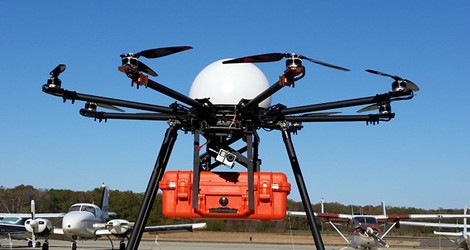A new drone delivery system that can transport emergency medical supplies and a communication system to patients and rescue personnel has been developed.
A new drone delivery system that can transport emergency medical supplies and a communication system to patients and rescue personnel was launched in a simulated mass casualty event in Mississippi.
The telemedical drone project, dubbed Health Integrated Rescue Operation (Hiro), was developed by Senior Associate Dean at William Carey University College of Osteopathic Medicine (WCUCOM), Italo Subbarao, and fourth year medical student, Guy Paul Cooper.
Two new telemedical packages were deployed during the demonstration, one for a severely injured victim and the other for a mass casualty setup capable of treating up to 100 people with significant to minor injuries. Both kits incorporate Homeland Security recommendations provided through the “Stop the Bleed” initiative.
The drone system delivers a case that includes medical supplies as well as cellular-connected Google Glass smart glasses. A person near the stricken patient is expected to put on the glasses, which send the video in front of them to a remote physician. The physician can then see what’s going on and lead the deputised civilian through the necessary treatment steps that utilise the supplies in the case.
“Reaching the victims is the critical challenge in these situations. As an osteopathic physician, my goal was to find ways to help save lives. A medical drone is the bridge that delivers life-saving treatment directly to the victims, giving remote physicians eyes, ears and voice to instruct anyone on site,” said Dr Subbarao.
The concept arose when the Subbarao and Cooper studied the medical response to the devastating EF-4 tornado that struck Hattiesburg, Mississippi, in February 2013.
In the past two years, they’ve developed multiple prototypes to support rural and wilderness medical emergencies, including the two newest iterations: ambulance drones designed to support victims and rescue personnel during mass shootings, bombings or other terrorist attacks.
“These drones have impressive lift and distance capability, and can be outfitted with a variety of sensors, such as infrared, to help locate victims,” said Director of the Unmanned Aerial Vehicle Programme at Hinds Community College, Dennis Lott. Lott collaborated with Dr Subbarao and Paul Cooper on the project.
“Working together, we’re able to develop, test, and bring this technology to the field. It is just a matter of time before the drones are universally adopted for emergency and disaster response toolkits,” concluded Lott.
For more information contact news@eHealthNews.co.za, like us on Facebook or tweet us @eHealthNewsZA.
Source: http://ehealthnews.co.za/ambulance-drone-system-takes-off
